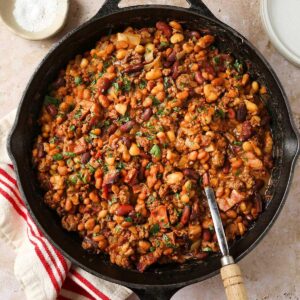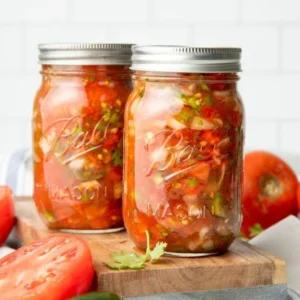Poultry seasoning is a timeless and aromatic blend of herbs and spices that can elevate any poultry dish, from roasted chicken to turkey, stuffing, and beyond. Its origins trace back to traditional European and American kitchens, where it became a staple in both savory and seasonal dishes. The perfect poultry seasoning recipe provides a delightful balance of flavors, featuring a mixture of sage, thyme, rosemary, and other herbs that add complexity to dishes. This seasoning is beloved for its versatility, capable of enhancing everything from grilled chicken to creamy casseroles, making it a must-have in every home cook’s pantry.
Ingredients
To make your own poultry seasoning at home, you’ll need the following ingredients:
-
1 tablespoon dried sage
-
1 tablespoon dried thyme
-
1 tablespoon dried rosemary
-
1 tablespoon dried parsley
-
1 teaspoon ground black pepper
-
1 teaspoon onion powder (optional)
-
1/2 teaspoon garlic powder (optional)
Substitutions:
-
For a gluten-free version, ensure all ingredients are gluten-free certified.
-
If you prefer a spicier seasoning, consider adding a pinch of cayenne pepper or red pepper flakes.
-
You can substitute dried herbs with fresh ones, just be sure to use about three times the amount of fresh herbs as the dried ones.
Step-by-Step Cooking Instructions



-
Measure the Spices:
Begin by measuring out the dried sage, thyme, rosemary, and parsley into a small bowl or jar. Ensure you have the right proportions, especially if you’re looking to match the flavors of your favorite store-bought poultry seasoning. -
Add the Optional Ingredients:
If you’re using onion powder or garlic powder for an extra layer of flavor, add them now to the mix. These spices will give your seasoning a more savory and aromatic profile. -
Grind the Herbs (if needed):
If you prefer a finer texture, use a spice grinder or mortar and pestle to grind the rosemary and thyme. This helps release more oils from the herbs, making the seasoning even more fragrant and potent. -
Mix Well:
Once all ingredients are added, stir well to ensure everything is evenly distributed. If you’re making a large batch, consider storing the mix in an airtight container to keep the spices fresh. -
Storage:
Transfer your poultry seasoning to a clean, dry jar. Seal tightly and store in a cool, dark place for up to 6 months.
Pro Tips and Cooking Techniques
-
Blending the Spices: If you want a smoother, more uniform texture, feel free to blend your herbs in a spice grinder or use a mortar and pestle. The grinding process helps release the natural oils of the herbs, providing a more fragrant blend.
-
Enhancing Flavor: To further enhance the flavor of your poultry seasoning, try adding a pinch of lemon zest or a dash of smoked paprika for a slightly smoky twist.
-
Proper Storage: Keep your homemade seasoning in an airtight container to preserve its freshness. Store it in a cool, dark place away from direct sunlight and heat sources.
Variations and Customizations
-
Vegetarian Version: Poultry seasoning is not just for poultry! You can use this seasoning blend for vegetables, tofu, or even as an addition to stuffing for a vegetarian meal.
-
Low-Carb Variation: To make the seasoning blend keto-friendly, just stick to the basic ingredients and avoid any unnecessary fillers.
-
Regional Adaptations: Try adding different herbs based on the cuisine you want to highlight, like dill for a Scandinavian twist or cumin for a Middle Eastern variation.
Serving Suggestions
Poultry seasoning can be used in a wide range of dishes, making it incredibly versatile. Here are some ideas for serving your dishes:
-
Roasted Chicken or Turkey: Rub the seasoning directly onto the poultry before roasting for a savory and aromatic dish.
-
Stuffing: Mix into your stuffing for an added depth of flavor.
-
Grilled Veggies: Sprinkle over vegetables like potatoes, carrots, and bell peppers for a savory, herbaceous side dish.
For beverages, consider pairing with a crisp white wine or a light beer to balance the flavors of the dish.
Nutritional Information
Here’s an approximate breakdown of the nutritional content per teaspoon (about 1.5 grams) of poultry seasoning:
-
Calories: 5 kcal
-
Protein: 0.2g
-
Carbohydrates: 1g
-
Fats: 0.1g
-
Fiber: 0.4g
-
Sodium: 1mg (varies depending on the type of salt used, if any)
Frequently Asked Questions (FAQs)
-
Can I use fresh herbs instead of dried?
Yes, you can substitute fresh herbs, but you’ll need to use about three times the amount of fresh herbs compared to dried. -
How should I store my poultry seasoning?
Store it in an airtight container in a cool, dark place. It will keep for several months. -
Can I add salt to the poultry seasoning?
You can, but it’s recommended to keep the salt separate to control the amount added when cooking. This keeps the seasoning more versatile. -
How can I use this seasoning in non-poultry dishes?
It works great with vegetables, potatoes, or even in a savory bread recipe.
Closing Thoughts
Poultry seasoning is a simple yet essential blend that can bring bold flavors to your kitchen. Whether you’re roasting a chicken or making a vegetarian dish, this seasoning mix adds just the right balance of savory, herby goodness. The best part? It’s easy to make and incredibly versatile. So, get creative and experiment with how you use your poultry seasoning!



